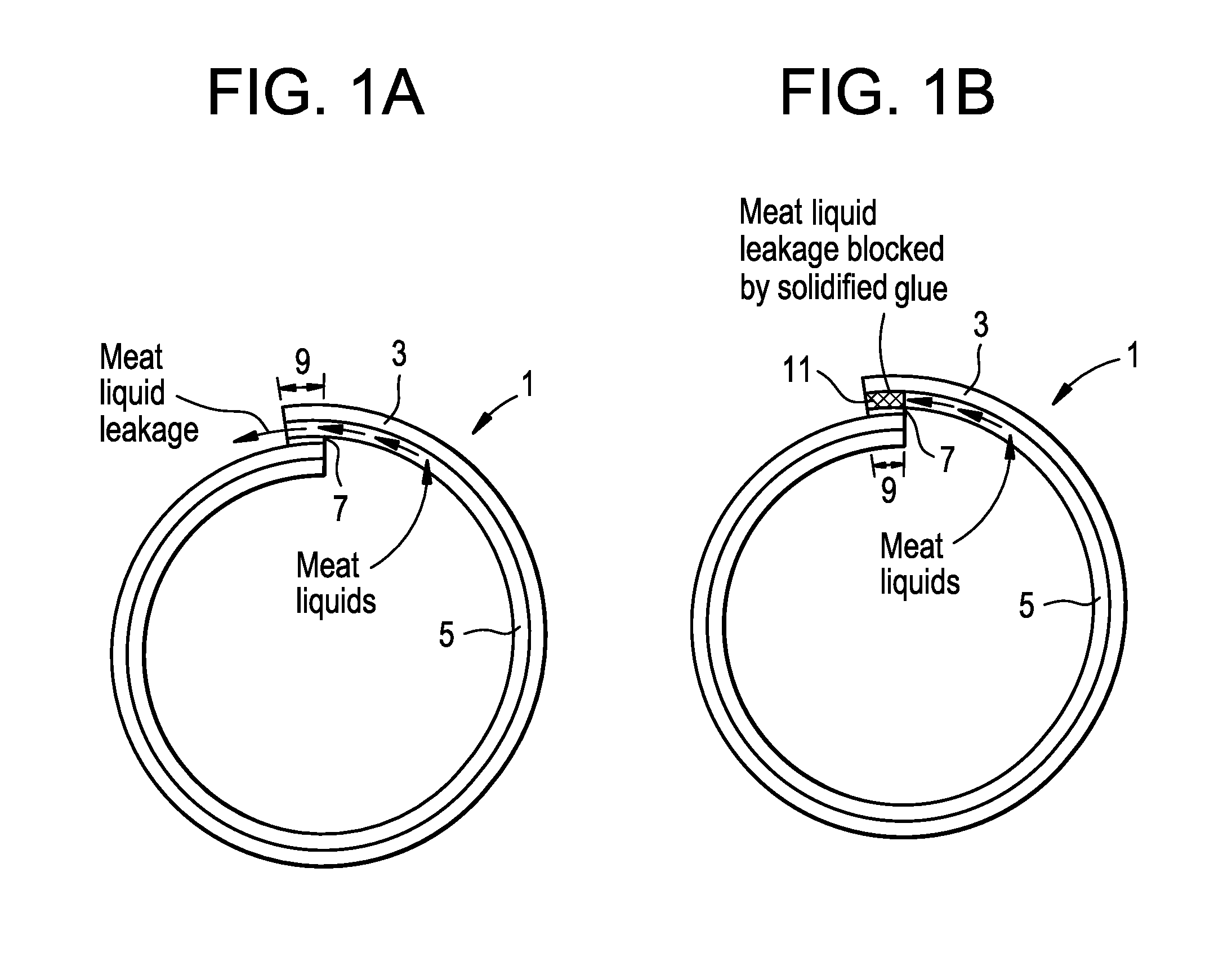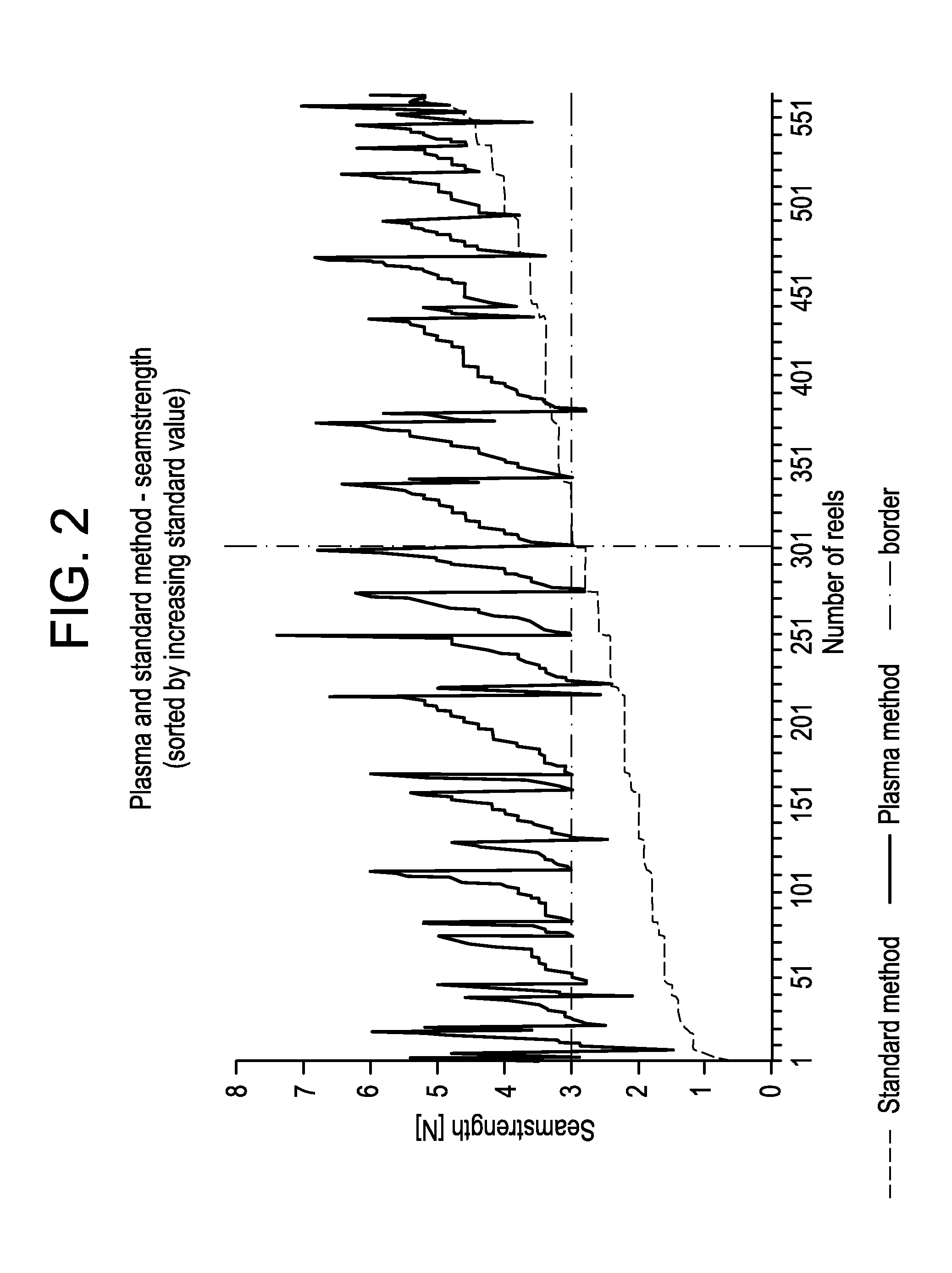Tubular Food Casing Having Glued, Permanently Elastic Longitudinal Seam
a technology of longitudinal seams and food casings, applied in the field of tubular food casings, can solve the problems of constant glue use, high cost, incomplete coating, etc., and achieve the effects of good mechanical properties of textile support materials, high transfer functions, and increased seam strength values
- Summary
- Abstract
- Description
- Claims
- Application Information
AI Technical Summary
Benefits of technology
Problems solved by technology
Method used
Image
Examples
example 1
[0063]A woven fabric of 100% polyester having a weight per unit area of 70 g / m2 and coated with colorless acrylic resin by doctor knife application. After drying and condensation, the textile thus coated had a total weight of 95 g / m2. The open-width product was cut into strips having a width of 152 mm which were then formed on a continuous casing machine at a speed of 0.8 m / s via a forming shoulder to give bond-free tubes having 15 mm overlapping longitudinal edges. The overlapping longitudinal edges were glued in two lines at a center-line distance apart of 4 mm using a reactive PUR hotmelt glue applied at a rate of 0.7 g / s immediately after applying a 10 mm wide plasma surface treatment at both faces of the adhesion surface, i.e. the overlapping longitudinal edges in at least the area to which the glue is subsequently applied. The plasma treatment was applied, upstream of the glue application, in-line to both of the longitudinal edges used to produce the seam of the formed tube vi...
example 2
[0065]A mixed woven fabric of 80% cotton and 20% polyester having a weight of 102 g / m2 was enzymatically desized, coated with a 6 wt % butyl acrylate emulsion polymer, dried and subsequently one-side coated with colored 65 wt % acrylic by doctor knife application and dried. After a finishing application of a PVDC outer layer, drying and condensation, the textile thus coated, i.e. the open-width product, had a total weight of 135 g / m2. This open-width product was cut into strips having a width of 365 mm which were then formed to give bond-free tubes with 25 mm overlapping longitudinal edges via a forming shoulder on a continuous casing machine running at a speed of 1.2 ms. Then, a 15 mm wide plasma was applied in-line to both of the longitudinal edges which were used to produce the seam of the formed tube via a plasma generator from Diener Plasma Beam, Type M1 with a plasma jet. The pressure of the plasma applied was 4 bar. The distance of the jet to the casing surface was 5 mm. The ...
example 3
[0068]To evaluate the influence of the plasma method on the seam strength, measurements were performed in a larger scale production. Bonded reels were produced in a special way to directly enable comparison of seam strength with and without plasma pre-treatment. The bonded reels were formed from open-width product according to Example 2. The open-width product was initially taken up on rolls. The open-width product was then slit into strips having a width of 365 mm and the strips taken up on reels. A reel of strip was then formed and bonded into a seamed casing via a forming shoulder on a continuously operating casing machine to give tubes in accordance with Example 2. The vast majority of the casing produced was also subjected to a surface treatment prior to glue application, in accordance with Example 2. However, to compare the bonding imparted without the surface treatment, a small length of the casing was not subject to the treatment, i.e. the plasma surface treatment was turned...
PUM
 Login to View More
Login to View More Abstract
Description
Claims
Application Information
 Login to View More
Login to View More - R&D
- Intellectual Property
- Life Sciences
- Materials
- Tech Scout
- Unparalleled Data Quality
- Higher Quality Content
- 60% Fewer Hallucinations
Browse by: Latest US Patents, China's latest patents, Technical Efficacy Thesaurus, Application Domain, Technology Topic, Popular Technical Reports.
© 2025 PatSnap. All rights reserved.Legal|Privacy policy|Modern Slavery Act Transparency Statement|Sitemap|About US| Contact US: help@patsnap.com



